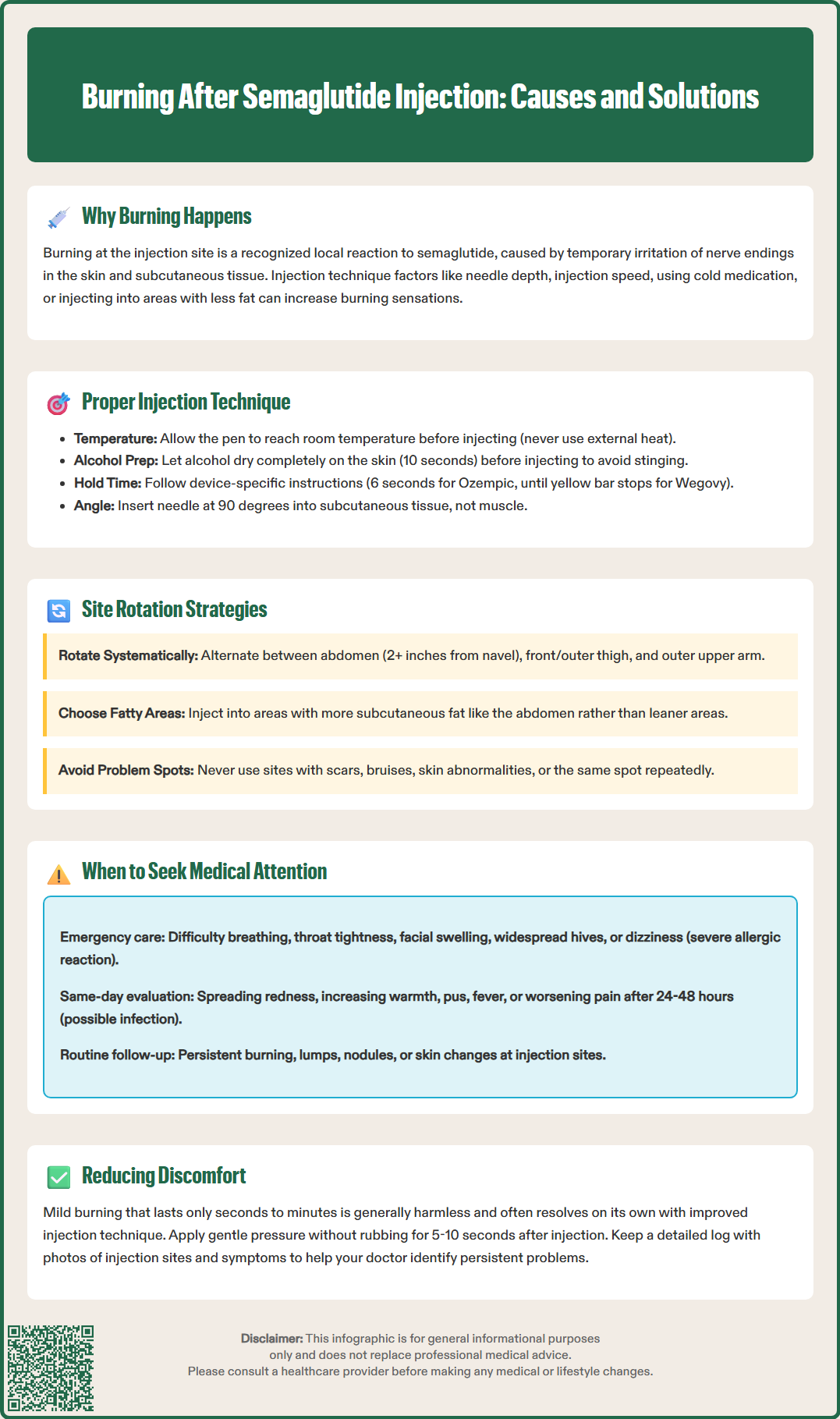LOSE WEIGHT WITH MEDICAL SUPPORT — BUILT FOR MEN
- Your personalised programme is built around medical care, not willpower.
- No generic diets. No guesswork.
- Just science-backed results and expert support.
Find out if you’re eligible

Burning after semaglutide injection is a common local reaction experienced by some patients using this GLP-1 receptor agonist for type 2 diabetes or chronic weight management. This temporary discomfort typically results from subcutaneous needle insertion, individual tissue sensitivity, or injection technique factors. While usually mild and self-limiting, understanding why burning occurs and how to minimize it can significantly improve treatment comfort and adherence. Most patients find that optimizing injection technique, proper site rotation, and allowing medication to reach room temperature effectively reduce or eliminate this sensation. Recognizing when burning requires medical attention versus normal post-injection discomfort is essential for safe semaglutide use.
Quick Answer: Burning after semaglutide injection is a common, usually mild local reaction caused by subcutaneous needle insertion and tissue irritation that typically resolves within minutes.
Semaglutide is a glucagon-like peptide-1 (GLP-1) receptor agonist administered subcutaneously for type 2 diabetes management and chronic weight management. A burning sensation at the injection site is a recognized local reaction that some patients experience, which falls under the broader category of injection-site reactions reported in FDA labeling.
The burning sensation typically results from several factors related to the injection process itself. The subcutaneous administration of any medication can cause temporary irritation of nerve endings in the skin and subcutaneous tissue. Semaglutide has a pH of approximately 7.4 in its formulated solution, which is physiologically neutral, but individual tissue sensitivity varies. The injection volume (which varies by product: Ozempic volumes differ by dose/pen concentration, while Wegovy uses a 0.75 mL single-dose autoinjector) and injection technique can influence local discomfort.
Additionally, the burning may be related to injection technique variables including needle depth, injection speed, or inadvertent intradermal administration rather than proper subcutaneous placement. Cold medication directly from refrigeration may potentially intensify discomfort for some patients. Some patients report that the burning correlates with injection into areas with less subcutaneous fat or into sites used repeatedly without adequate rotation.
It is important to distinguish between a mild, transient burning sensation lasting seconds to minutes—which is generally benign—and more concerning signs such as persistent pain, spreading redness, swelling, or warmth that might indicate infection or allergic reaction. Most patients who experience burning find it resolves spontaneously within minutes and does not recur with subsequent injections when technique is optimized.

Several strategies can minimize or eliminate burning sensations associated with semaglutide injections. These techniques focus on optimizing injection conditions and patient comfort without compromising medication efficacy.
Temperature management may help improve comfort. For patient comfort, you may allow the semaglutide pen to reach room temperature before injection by removing it from refrigeration. Cold medication might contribute to injection discomfort for some patients. Never use external heat sources to warm the medication, as this may degrade the protein structure of semaglutide. Always follow the product-specific Instructions for Use (IFU) for proper storage and handling.
Injection technique significantly impacts comfort. Follow your device's specific IFU carefully. For Ozempic multi-dose pens, depress the dose button completely and keep the needle in place for 6 seconds after the dose counter shows "0" to ensure complete dose delivery. For Wegovy single-dose autoinjectors, follow the device-specific hold time until the yellow bar stops moving. Complete medication delivery helps reduce leakage, which can cause skin irritation.
Site preparation should include proper cleansing with alcohol and allowing the skin to dry completely before injection. Residual alcohol on the skin can cause stinging when the needle penetrates. Apply gentle pressure (without rubbing) to the injection site for 5-10 seconds after withdrawing the needle.
Site rotation is essential. Rotate between recommended injection sites—abdomen, thigh, and upper arm—and avoid injecting into the same spot repeatedly. Follow a systematic rotation pattern according to your healthcare provider's guidance. Repeated use of the same site can cause lipohypertrophy or tissue changes that increase discomfort.
Some patients find that injecting into areas with more subcutaneous fat, such as the abdomen (at least 2 inches from the navel), produces less burning than leaner areas. Avoid injecting into areas with scars, bruises, or skin abnormalities.
While mild, transient burning is generally benign, certain signs and symptoms warrant prompt medical evaluation. Patients should be educated to recognize concerning features that may indicate complications requiring clinical assessment.
Immediate medical attention is necessary if burning is accompanied by signs of severe allergic reaction (anaphylaxis), including difficulty breathing, throat tightness, rapid swelling of the face or tongue, widespread hives, or dizziness. Although rare with semaglutide, serious hypersensitivity reactions have been reported and require emergency treatment.
Same-day or next-day evaluation is appropriate for signs suggesting injection site infection (cellulitis or abscess formation). These include progressive redness spreading beyond the immediate injection site, increasing warmth, swelling, purulent drainage, fever, or pain that worsens rather than improves over 24-48 hours. Patients with diabetes or compromised immune function should be particularly vigilant about infection signs.
Routine clinical follow-up should be considered if patients experience persistent burning that doesn't resolve quickly after injection, burning that progressively worsens with successive doses, or development of nodules, lumps, or skin changes at injection sites. These findings may indicate lipohypertrophy, localized inflammatory reactions, or technique issues requiring assessment and education. The specific threshold for seeking care should be individualized based on clinical judgment and patient factors.
Patients should also report burning associated with systemic symptoms such as nausea, vomiting, or abdominal pain, as these may represent gastrointestinal adverse effects of semaglutide rather than injection site reactions. The prescribing information notes that gastrointestinal adverse effects are the most common reasons for treatment discontinuation.
Documentation of injection site reactions, including photographs when appropriate, can help clinicians assess severity and progression. Patients maintaining a log of injection sites, techniques used, and associated symptoms provide valuable information for troubleshooting persistent problems.
Correct injection technique is fundamental to minimizing discomfort and ensuring optimal medication delivery. Healthcare providers should provide comprehensive injection training at treatment initiation, with periodic reassessment to identify and correct technique errors. Always follow the FDA-approved Instructions for Use (IFU) for your specific device.
Preparation steps include hand hygiene and visual inspection of the medication (which should be clear and colorless). For Ozempic multi-dose pens, attach a new needle for each injection as specified in the IFU. Shorter needles (4-6 mm) are generally sufficient for subcutaneous injection in most patients and may reduce discomfort compared to longer needles. Wegovy comes as a single-dose autoinjector with a pre-attached needle.
Site selection and preparation should follow systematic rotation. For abdominal injections, choose areas at least 2 inches away from the navel, avoiding the waistline. For thigh injections, use the front and outer aspects of the thigh, midway between the knee and hip. Upper arm injections (outer aspect) may require assistance for proper administration. Cleanse the site with an alcohol swab using a circular motion and allow to air dry for at least 10 seconds.
Injection procedure for Ozempic involves:
Pinch the skin gently to elevate subcutaneous tissue (not necessary for all patients)
Insert the needle at a 90-degree angle
Release the skin pinch before injecting (if used)
Depress the dose button slowly and completely
Maintain pressure on the dose button while counting to 6 after the dose counter shows "0"
Withdraw the needle straight out
Injection procedure for Wegovy involves:
Following the autoinjector IFU exactly
Holding the autoinjector firmly against the skin at the injection site
Pressing and holding the button until the yellow bar stops moving
Lifting the device straight away from the skin after injection is complete
Post-injection care includes safe needle disposal in an FDA-cleared sharps container and avoiding rubbing the injection site, which can increase local irritation and potentially affect medication absorption. Patients should not recap needles due to needlestick injury risk.
Common technique errors that increase burning include inadequate skin drying after alcohol preparation, injecting into muscle rather than subcutaneous tissue, and reusing needles (with Ozempic). Needle reuse can cause dulling and barb formation, significantly increasing injection pain.
Comprehensive side effect management extends beyond injection site reactions to address the full spectrum of semaglutide-related adverse effects. The most common adverse reactions reported in clinical trials include nausea, vomiting, diarrhea, abdominal pain, and constipation, occurring in more than 5% of patients.
Gastrointestinal side effects are typically most pronounced during dose escalation and often diminish with continued treatment. The FDA-approved dosing schedule includes gradual titration specifically to improve gastrointestinal tolerability. For Ozempic, this typically starts at 0.25 mg once weekly for 4 weeks, then increasing to 0.5 mg, with further increases as needed. For Wegovy, the titration schedule is 0.25 mg, 0.5 mg, 1.0 mg, 1.7 mg, and finally 2.4 mg at 4-week intervals. Patients should be counseled that initial doses are subtherapeutic and primarily intended for tolerability.
Dietary modifications can help reduce gastrointestinal symptoms. Recommendations include eating smaller, more frequent meals; avoiding high-fat and spicy foods; staying well-hydrated; and eating slowly. Some patients report that taking semaglutide after eating something light rather than on an empty stomach helps with tolerability, though this is based on patient experience and not an official recommendation. Semaglutide can be administered without regard to meals.
Monitoring requirements include assessment for signs of pancreatitis (persistent severe abdominal pain, often radiating to the back, with or without vomiting) and gallbladder disease (right upper quadrant pain, nausea, vomiting), both of which have been reported with GLP-1 receptor agonists. For patients using Ozempic, diabetic retinopathy complications may occur, particularly in those with pre-existing retinopathy. Patients with severe gastrointestinal disease, including gastroparesis, should use semaglutide with caution.
For patients with type 2 diabetes, hypoglycemia risk increases when semaglutide is used concomitantly with insulin or sulfonylureas. Dose reduction of these medications may be necessary according to American Diabetes Association guidelines. Regular blood glucose monitoring and A1C assessment guide therapy adjustments.
Pregnancy considerations are important: Wegovy is contraindicated during pregnancy and should be discontinued at least 2 months before a planned pregnancy. Discuss appropriate contraception with your healthcare provider while using semaglutide.
Patient education should emphasize that most side effects are transient and manageable. However, patients should report persistent vomiting or diarrhea that could lead to dehydration and acute kidney injury, particularly in those with underlying renal impairment. Dose reduction or temporary treatment interruption may be necessary for intolerable side effects, with subsequent slower retitration. Healthcare providers should maintain open communication channels for patients to report concerns and receive guidance, optimizing treatment adherence and outcomes.
Yes, mild burning after semaglutide injection is a recognized local reaction that typically resolves within minutes. It results from subcutaneous needle insertion and temporary nerve ending irritation, and is generally benign when brief and self-limiting.
Allow the medication to reach room temperature before injection, ensure skin is completely dry after alcohol preparation, rotate injection sites systematically, and follow device-specific instructions for proper technique including appropriate hold times after injection.
Seek immediate medical attention for signs of severe allergic reaction (difficulty breathing, throat tightness, facial swelling). Contact your healthcare provider for spreading redness, increasing warmth, swelling, purulent drainage, fever, or burning that persists or worsens with successive doses.
All medical content on this blog is created using reputable, evidence-based sources and is regularly reviewed for accuracy and relevance. While we strive to keep our content current with the latest research and clinical guidelines, it is intended for general informational purposes only.
This content is not a substitute for professional medical advice, diagnosis, or treatment. Always consult a licensed healthcare provider with any medical questions or concerns. Use of this information is at your own risk, and we are not liable for any outcomes resulting from its use.